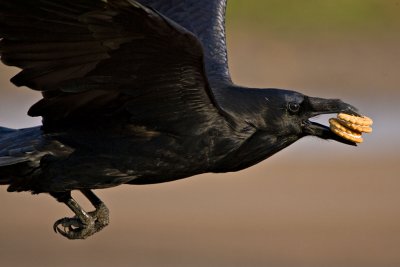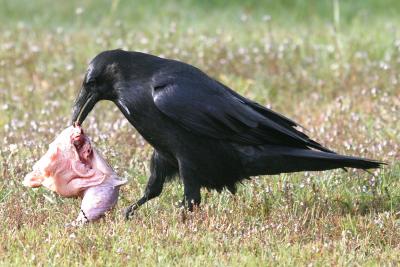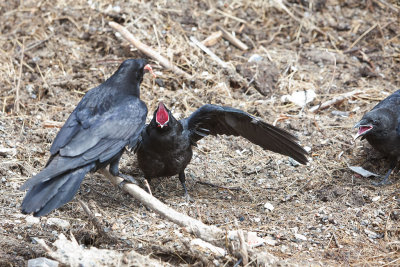Nutrition
Corvus corax is an omnivore; this means that it consumes both plant matter as well as the tissues of other organisms for energy. Living in such a large range of habitats and environments the common raven has the ability to be very diverse in what foods in consumes. With a wide range of techniques used to obtain food this extremely versatile bird can be observed scavenging food from human garbage and animal carcasses, gathering seeds and fruits, and more often than not, preying upon other animals.
Food habits
 Common ravens have multiple techniques that they use to obtain
and store food. Feeding singularly or more commonly in “crowds” the
common raven has the opportunity to obtain a large variety of food . They will often hunt in “crowds” in order to attack birds or
animals that are larger than themselves. This is useful as it gives
the common raven the ability to eat organisms that it could not overpower on its own (Boarmen 1999). Another food habit that the common raven
uses is food caching. These birds will carry pieces of meat or other
edible and non-edible materials back to their roosts where they will
then camouflage it caches. Common ravens will often raid each
other’s caches, and that is why it is extremely important that they
do camouflage their own .This habit of caching food has been
observed throughout both young and old common ravens, and is used as
a way to store food as well as other materials and resources for
later use (Bugnyar 2007).
Common ravens have multiple techniques that they use to obtain
and store food. Feeding singularly or more commonly in “crowds” the
common raven has the opportunity to obtain a large variety of food . They will often hunt in “crowds” in order to attack birds or
animals that are larger than themselves. This is useful as it gives
the common raven the ability to eat organisms that it could not overpower on its own (Boarmen 1999). Another food habit that the common raven
uses is food caching. These birds will carry pieces of meat or other
edible and non-edible materials back to their roosts where they will
then camouflage it caches. Common ravens will often raid each
other’s caches, and that is why it is extremely important that they
do camouflage their own .This habit of caching food has been
observed throughout both young and old common ravens, and is used as
a way to store food as well as other materials and resources for
later use (Bugnyar 2007).
Click Here to see a common raven caching food!
Adults
The common raven has a tremendously diverse diet, it feeds upon
reptiles,
frogs, young and wounded birds, eggs, insects, arthropods
(including scorpions), fish, mollusks, small and large mammals (the
later as scavengers), grains, berries,
fruits, buds, and carrion . Not all common ravens feed on every one of these organisms;
variance amongst diet is subject to change with local environments
and ecosystems. Factors within local habitats that may affect what
these birds feed on can be influenced by the change in seasons.
Weather, as well as the availability of prey and plants within
differing seasons, can be important influences that determine what
foods the common raven will eat (Boarmen 1999). Organisms (plants and
animals) do not entirely makeup the diet of the common raven. Common
ravens
can often be observed eating garbage from landfills when living in
close association with humans as well (Schwan 2008). Observation of this
bird is important to understanding their diet, but a lot of the
information that is known about the diet of Corvus corax
has been determined by the examination of their pellets that like
most owls and hawks they regurgitate (Schwan 2008). The information that
has been obtained by these examinations has shown that the majority
and most important part of the common raven diet consist of eating
mammals (Boarmen 1999). All of these food sources are capable of being
a part of an adult common raven diet, but there are some differences
in what juveniles of this species eat and how they obtain their
food.
feed on every one of these organisms;
variance amongst diet is subject to change with local environments
and ecosystems. Factors within local habitats that may affect what
these birds feed on can be influenced by the change in seasons.
Weather, as well as the availability of prey and plants within
differing seasons, can be important influences that determine what
foods the common raven will eat (Boarmen 1999). Organisms (plants and
animals) do not entirely makeup the diet of the common raven. Common
ravens
can often be observed eating garbage from landfills when living in
close association with humans as well (Schwan 2008). Observation of this
bird is important to understanding their diet, but a lot of the
information that is known about the diet of Corvus corax
has been determined by the examination of their pellets that like
most owls and hawks they regurgitate (Schwan 2008). The information that
has been obtained by these examinations has shown that the majority
and most important part of the common raven diet consist of eating
mammals (Boarmen 1999). All of these food sources are capable of being
a part of an adult common raven diet, but there are some differences
in what juveniles of this species eat and how they obtain their
food.
Click Here to see a common raven eating!
Young
 Juvenile common ravens are very reliant on their parents for
food. They cannot fly initially when hatched or at a juvenile age,
so they rely on their parents to hunt and scavenge for them.
Parent common ravens have been observed initially feeding their
offspring insects. After a few days they will then begin to give
their young pieces of mice and other small mammals. In order to make
the food easier for their young to digest, parents will drink water
before they give it to their babies so that the food is softer
(Goodwin 1986).
Juvenile common ravens are very reliant on their parents for
food. They cannot fly initially when hatched or at a juvenile age,
so they rely on their parents to hunt and scavenge for them.
Parent common ravens have been observed initially feeding their
offspring insects. After a few days they will then begin to give
their young pieces of mice and other small mammals. In order to make
the food easier for their young to digest, parents will drink water
before they give it to their babies so that the food is softer
(Goodwin 1986).
Go to Reproduction to learn about how the common raven reproduces!
Back to Top
Back to Homepage
